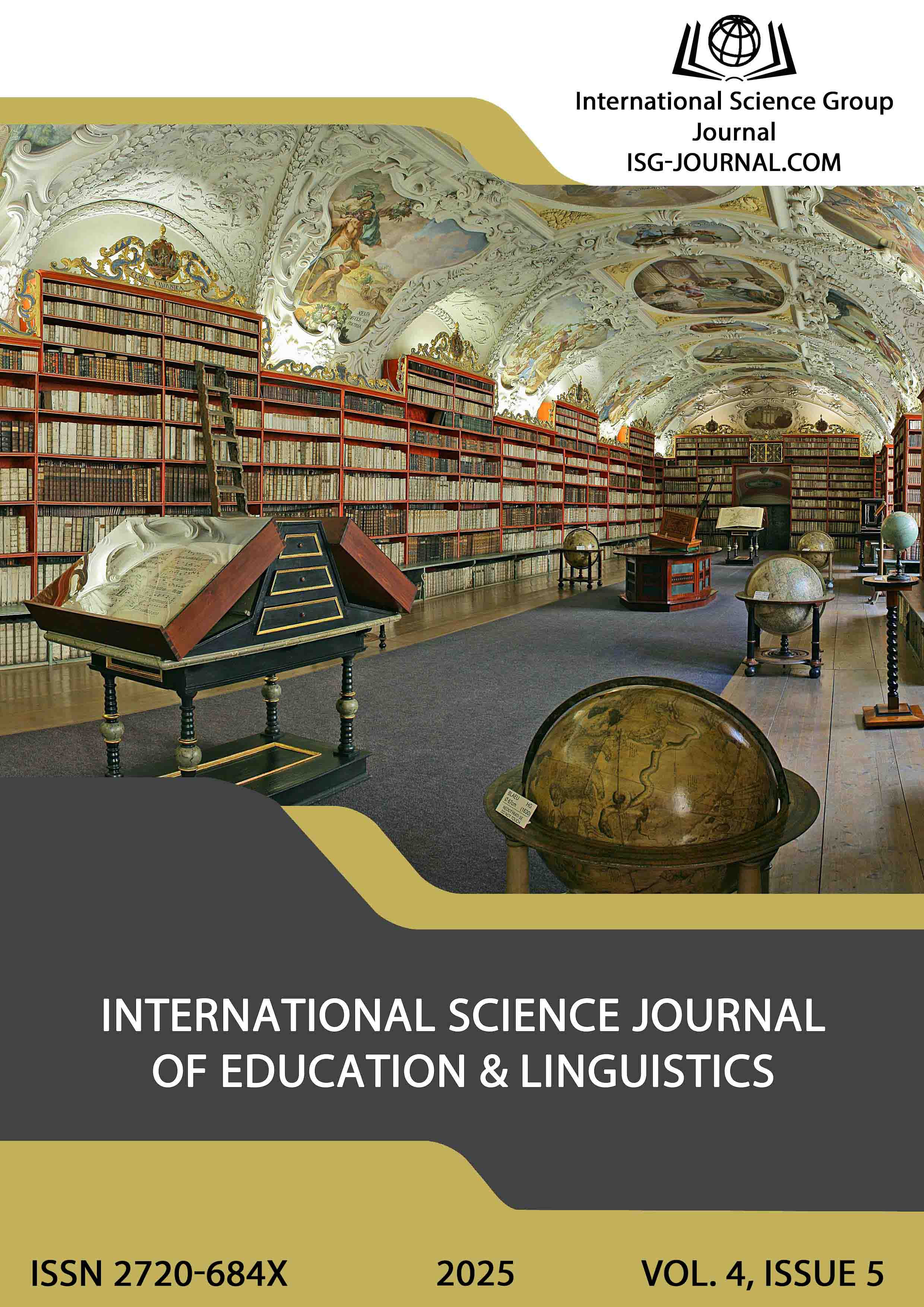Education as a driver of investment awareness: the role of ethical mission-oriented organizations in the transparent development of human capital
DOI:
https://doi.org/10.46299/j.isjel.20250405.01Keywords:
human capital, ethical mission-oriented organizations, educational intervention, institutional trust, governance transparency, civic participation, accountability, regular contributions, digital literacy, microlearning, mentorshipAbstract
The article examines how education, institutional trust, and governance transparency channel voluntary contributions from citizens and small and medium-sized enterprises into ethical mission-oriented organizations and convert them into gains in human capital. The theoretical foundation is a logic-structural approach that links input resources, onboarding and accountability processes, immediate participation outcomes, and long-term changes in education, culture, and healthcare; the empirical component is a panel model that accounts for current and lagged participation, trust indicators, and a transparency index. Using 2023 data, the study shows that Ukraine substantially exceeds global averages in the share of individuals making donations and in trust in civic institutions, which – together with an adequate educational foundation – creates a unique window of opportunity for scaling investment in human capital development. It is substantiated that low–cognitive-load educational interventions (microlearning, decision simulators, mentorship) reduce information asymmetry and entry barriers, while transparency and stewardship increase the efficiency with which contributions are converted into measurable outcomes. A minimal set of indicators for regular monitoring and evaluation is proposed, along with procedures for causal identification of impacts based on panel data, differences-in-differences, and event-study designs. The identified limitations concern the lack of standardized data on the regularity of participation and the absence of established transparency indicators, which underscores the need to institutionalize them and publish them in machine-readable format. Practical recommendations include developing subscription mechanisms for regular micro-contributions, implementing independent audits and open dashboards, and updating educational programs with a focus on plain language and digital skills. The results have applied significance for public authorities, civil society organizations, and businesses seeking transparent and sustainable human capital development through civic participation and responsible governance.References
Al-Afeef, M. A., & Alsmadi, A. A. (2025). Digital Empowerment: Unraveling the Impact of Digital Literacy on Financial Mastery. Discover Sustainability, 6 (311). https://doi.org/10.1007/s43621-025-01137-5
CFA Institute. (2022). Enhancing Investors’ Trust: 2022 CFA Institute Investor Trust Study. https://www.cfainstitute.org/sites/default/files/-/media/documents/article/Enhancing-Investors-Trust-Report_2022_Online.pdf
Charities Aid Foundation (CAF). (2024). World Giving Index 2024: Global Trends in Generosity. Inside Giving series. https://www.cafonline.org/docs/default-source/inside-giving/wgi/wgi_2024_report.pdf
Chhillar, N., Sharma, K., & Arora, S. (2025). Exploring the Role of Digital Financial Literacy and Personal Financial Behavior in Shaping Financial Stress and Well-being in the Digital Age. Acta Psychologica, 259, 105308. https://doi.org/10.1016/j.actpsy.2025.105308
Choung, Y., Chatterjee, S., & Pak, T.-Y. (2023). Digital Financial Literacy and Financial Well-being. Finance Research Letters, 58, 104438. https://doi.org/10.1016/j.frl.2023.104438
Feng, N. C., & Greenlee, J. S. (2024). Governance, Performance, and Compensation in Nonprofit Organizations: A Review of Recent Empirical Nonprofit Research. Journal of Governmental & Nonprofit Accounting, 13(1), 1–27. https://doi.org/10.2308/JOGNA-2023-006
Gallego, R. (2022). Community Foundation Building: Identifying Key Capacities for the Spanish Context. Center on Philanthropy and Civil Society (CUNY). https://www.gc.cuny.edu/sites/default/files/2022-09/Rosa%20Gallego_Community%20foundation%20building.pdf
Haran Rosen, M., Lusardi, A., & Mitchell, O. S. (2025, April 12). Trust, Financial Literacy, and Financial Behavior: Driving Retirement Security. Preliminary Draft. https://ifdm.stanford.edu/sites/g/files/sbiybj30991/files/media/file/haran_rosen_maya-trust_financial_literacy_and_financial_behavior_driving_retirement_security_0.pdf
Jung, J. (2024). Understanding Transparency Practices in Private Foundations. Nonprofit and Voluntary Sector Quarterly, 48(1), 50–62. https://doi.org/10.1177/07349149241231103
Merter, A. K., & Balcıoğlu, Ya. S. (2025). Financial Literacy and Decision-Making: The Impact of Metacognition. International Journal of Consumer Studies, 1–8. https://doi.org/10.1016/j.bir.2025.07.010
OECD/INFE. (2022). Toolkit for Measuring Financial Literacy and Financial Inclusion. OECD Publishing. https://www.oecd.org/content/dam/oecd/en/publications/reports/2022/03/oecd-infe-toolkit-for-measuring-financial-literacy-and-financial-inclusion-2022_54dba970/cbc4114f-en.pdf
OECD/INFE. (2023). International Survey of Adult Financial Literacy. OECD Publishing. https://www.oecd.org/content/dam/oecd/en/publications/reports/2023/12/oecd-infe-2023-international-survey-of-adult-financial-literacy_8ce94e2c/56003a32-en.pdf
Ocansey, E. O. N. D., & Manu, V. (2025). The Relationship between Financial Literacy and Financial Behavior: A Systematic Literature Review. Journal of Economics, Finance and Accounting Studies, 7(3), 101–116. https://al-kindipublishers.org/index.php/jefas/article/view/10377/9093
Prats, M., Smid, S., & Ferrin, M. (2024). Lack of Trust in Institutions and Political Engagement: An Analysis Based on the 2021 OECD Trust Survey. OECD Working Papers on Public Governance. OECD Publishing. https://www.oecd.org/content/dam/oecd/en/publications/reports/2024/11/lack-of-trust-in-institutions-and-political-engagement_ae8a8673/83351a47-en.pdf
Rubiyanty, I. M., Mubaroq, A. C., & Rafinda, A. (2025). The Effect of Accountability and Transparency on Cooperative Financial Management: Evidence from Indonesia. OWNER: Riset & Jurnal Akuntansi, 9(1), 491–500. https://doi.org/10.33395/owner.v9i1.2400
Taifur, M. A., & Ab Rahman, A. (2025). The Potential for Human Capital Development (HCD) through Waqf Fund. Online Journal of Islamic Management and Finance, 15(1), 96–113. https://ejournal.um.edu.my/index.php/OJIMF/article/view/60808
Yakoboski, P. J., Lusardi, A., & Hasler, A. (2021). The 2021 TIAA Institute–GFLEC Personal Finance Index (P-Fin Index). TIAA Institute & GFLEC. https://gflec.org/wp-content/uploads/2021/04/2021-P-Fin-Index-report-TIAA-Institute-GFLEC-April-2021.pdf
Zeng, Y., Chen, C., Wang, C., & Zou, J. (2025). Education Investment, Social Security, and Household Financial Market Participation. Finance Research Letters, 77, 107124. https://doi.org/10.1016/j.frl.2025.107124
Downloads
Published
How to Cite
Issue
Section
License
Copyright (c) 2025 Anastasiya Ilyina

This work is licensed under a Creative Commons Attribution 4.0 International License.





